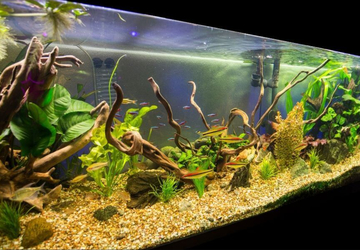Welcome to the fascinating world of custom aquariums, where you can create your underwater paradise. Designing and building your custom aquarium may sound like a daunting task, but with the right guidance and a bit of patience, it can be a rewarding experience. In this guide, we'll break down the process into manageable steps so you can dive right in and create a stunning aquatic masterpiece.
The first step in designing and building a custom aquarium is careful planning. Consider the size, shape, and location of your tank. Consider the type of aquatic life you want to keep, as this will determine the tank's requirements. Freshwater or saltwater? Tropical fish, corals, or a mix of both? Your choices will impact the equipment and setup needed.
Also, decide on the aquarium's theme and décor. Do you want a natural-looking reef or a whimsical underwater landscape? Once you have a clear vision, you can move on to the next steps.
The size and shape of your custom aquarium are critical.
Larger tanks provide more stability and room for various species but can be heavier and more expensive. Consider your available space and budget when making your choice.
Shapes vary from standard rectangles to unique designs like bow fronts or cylinders. Each has its aesthetic appeal, but remember that irregular shapes may pose maintenance and equipment placement challenges.
Custom aquariums can be made from different materials, with glass and acrylic being the most common. Glass is sturdy, scratch-resistant, and offers excellent clarity but is heavier. Acrylic is lighter and can be molded into various shapes, but it's more prone to scratching.
You can purchase pre-made tanks or have one custom-built to your specifications. If you choose to build your own, ensure you use aquarium-grade materials and adhere to proper construction techniques to avoid leaks.
Selecting the right equipment is crucial for maintaining a healthy environment for your aquatic life. Invest in a quality filtration system to remove impurities and maintain water quality. Consider a heater for tropical fish or a chiller for cold-water species.
Lighting is another essential aspect. Different species have varying lighting needs, so research the requirements of your chosen aquatic life and select appropriate lighting fixtures.

The substrate (the material on the tank's bottom) not only affects the aesthetics but also impacts the well-being of your aquatic life. Choose a substrate based on the needs of your species, whether it's sand, gravel, or a specialized substrate for plants.
Now, it's time to get creative with your decor. Add rocks, driftwood, and artificial or live plants to create a natural environment. Use non-toxic silicone to secure decorations in place.
Understanding water chemistry is vital to maintaining a stable environment. Invest in a quality test kit to monitor parameters like pH, ammonia, nitrites, and nitrates. Keep them within the ideal ranges for your specific aquatic life.
Before adding fish, perform the nitrogen cycle—a process that establishes beneficial bacteria to break down waste. This cycle can take several weeks, so be patient. Once it's complete, you can introduce your aquatic friends.
Aquascaping involves arranging the decor and plants to create a visually pleasing and functional underwater landscape. Balance aesthetics with providing hiding spots and swim areas for your fish.
If you plan to include live plants, research their care requirements. Consider lighting, substrate, and fertilization to ensure your plants thrive.
When introducing fish to your custom aquarium, be mindful of compatibility. Different species have different temperaments and water parameter preferences. Avoid overcrowding, as it can lead to stress and territorial disputes.
Regular water changes and maintenance are essential for a healthy aquarium. Clean the glass, remove debris, and perform water tests regularly to keep the environment stable.
Your custom aquarium is a dynamic ecosystem that may require adjustments over time. Pay attention to the behavior and health of your aquatic life. If issues arise, like aggression or poor water quality, be prepared to make changes to improve the habitat.
Also, stay informed about advancements in aquarium technology and best practices. The world of aquarium keeping is ever-evolving, and new tools and knowledge can help you create a thriving ecosystem.
Lastly, remember to enjoy the fruits of your labor. Your custom aquarium is not just a display; it's a living work of art. Take the time to observe and appreciate the beauty and tranquility of your underwater world. Share your passion with others and continue learning to ensure the well-being of your aquatic companions.
Set aside moments to sit beside your aquarium and simply watch as your fish gracefully glide through the water, plants sway in the currents, and colors dance in the soft lighting. It's a therapeutic experience that can help reduce stress and bring a sense of serenity to your life. Invite friends and family to marvel at your creation.

Even with the best planning and care, aquariums can encounter problems. Identifying and addressing these issues is essential for maintaining a healthy aquatic environment.
Algae Overgrowth: Algae can quickly become a nuisance, clouding the water and covering surfaces. To combat this, maintain a proper light cycle, avoid overfeeding, and consider introducing algae-eating fish or invertebrates. Regular water changes and algae scraping can also help keep algae in check.
Water Quality Fluctuations: Water parameters like pH, ammonia, nitrites, and nitrates can fluctuate, affecting your fish's health. Regular testing and water changes are vital. Invest in a reliable water conditioner to neutralize harmful substances like chlorine and chloramine.
Sick Fish: If you notice your fish displaying abnormal behavior, such as lethargy, loss of appetite, or unusual growth, it may indicate illness. Isolate the affected fish, research the symptoms, and consult with an experienced aquarist or a vet specializing in aquatic species for diagnosis and treatment options.
Building and maintaining a custom aquarium is a fulfilling hobby that allows you to create a piece of nature within your home. With careful planning, dedication, and creativity, you can design a unique aquatic masterpiece that brings joy and wonder to your life for years.